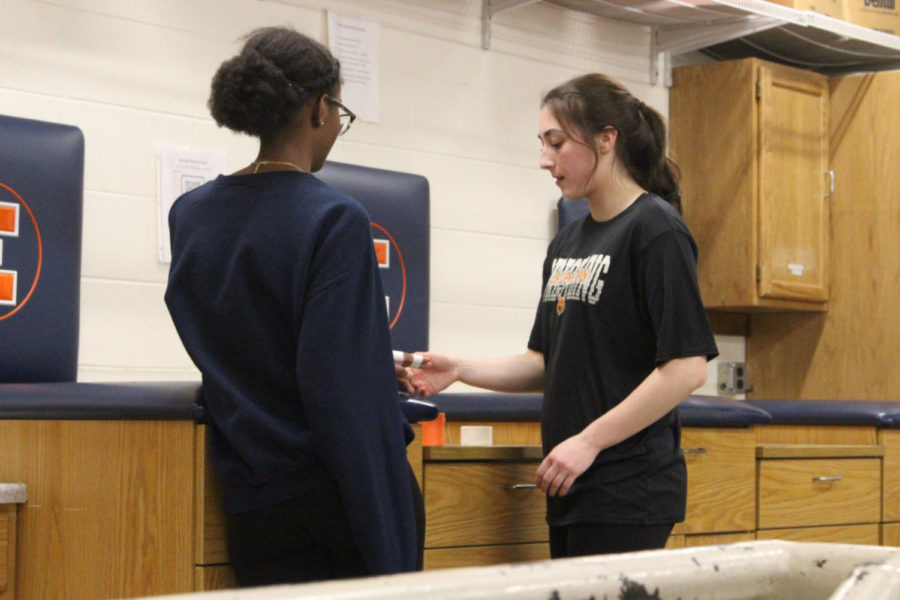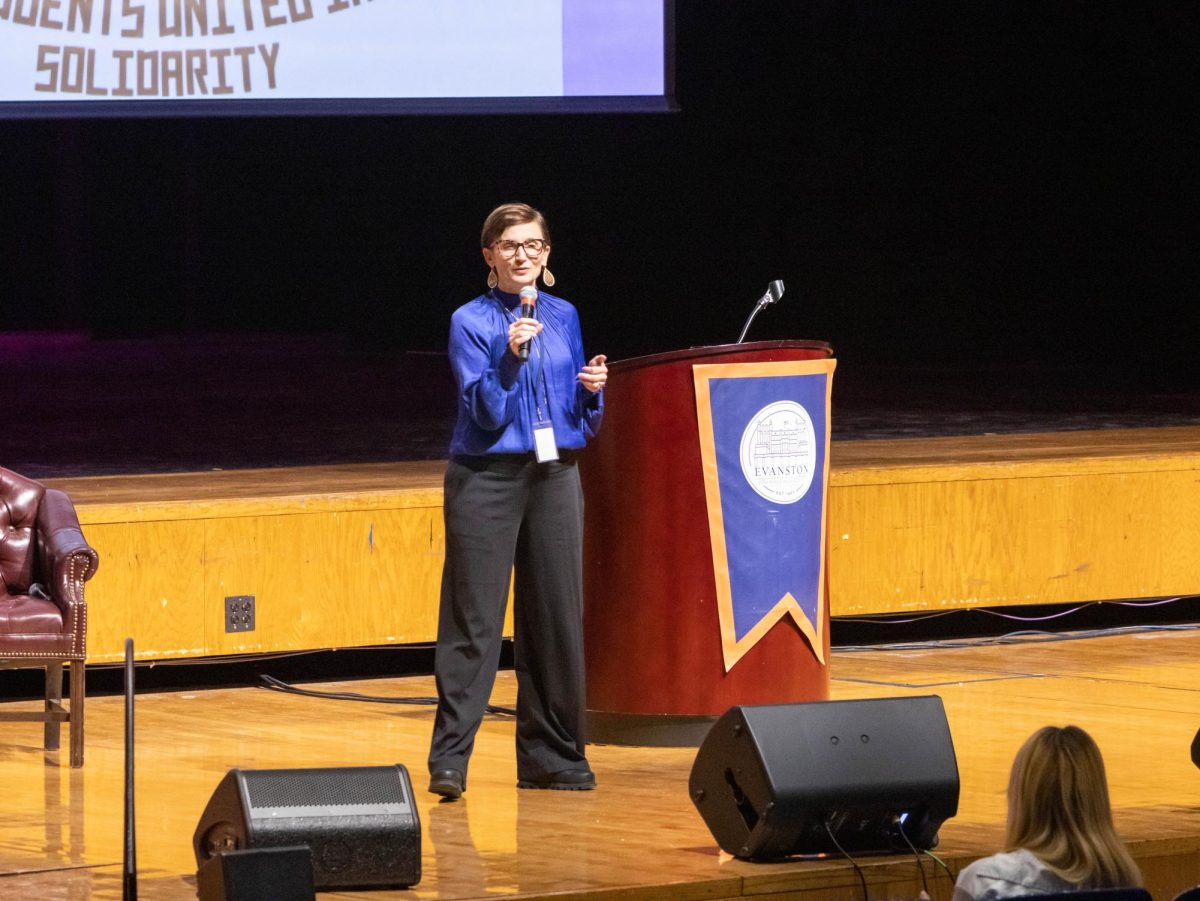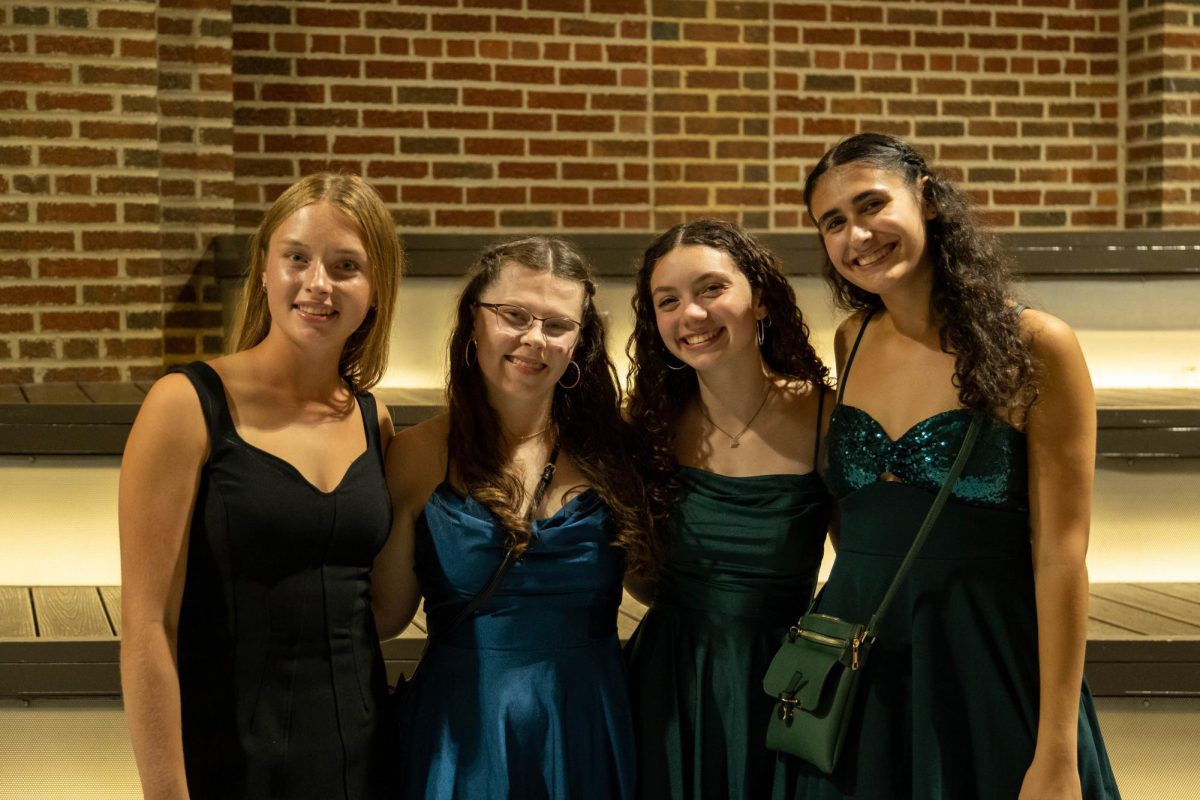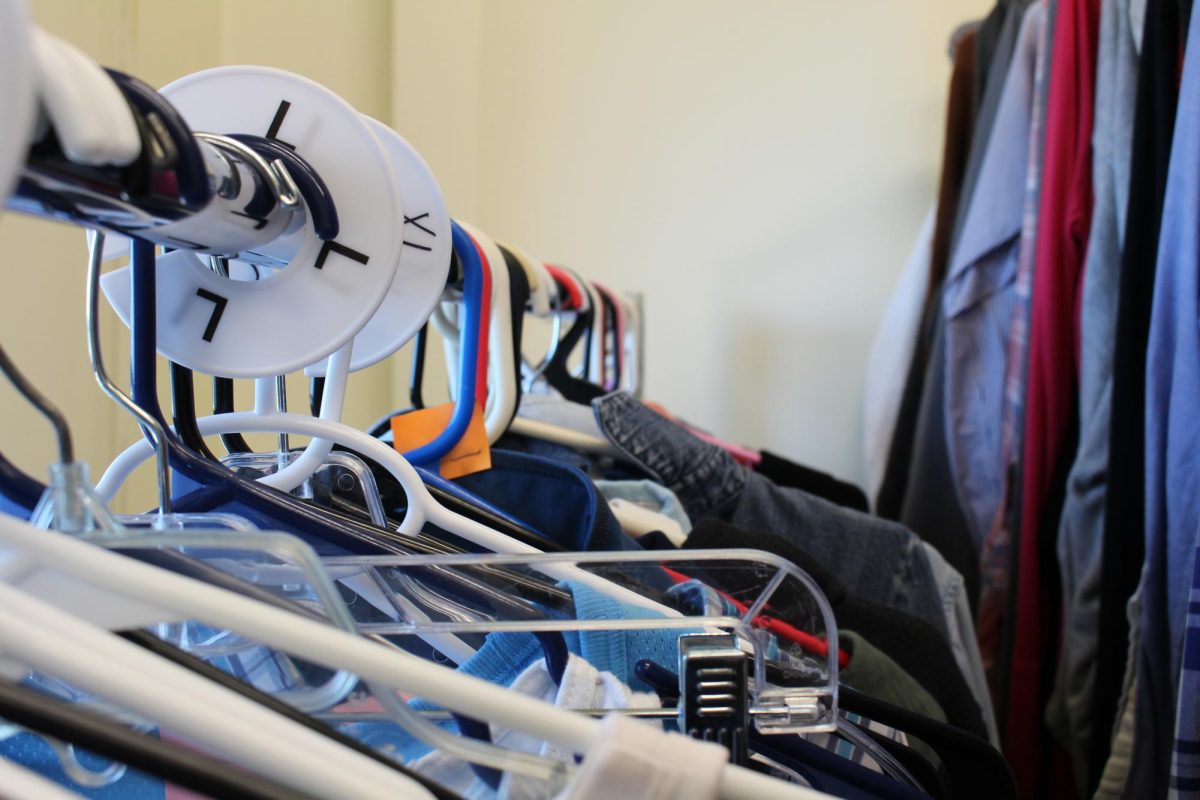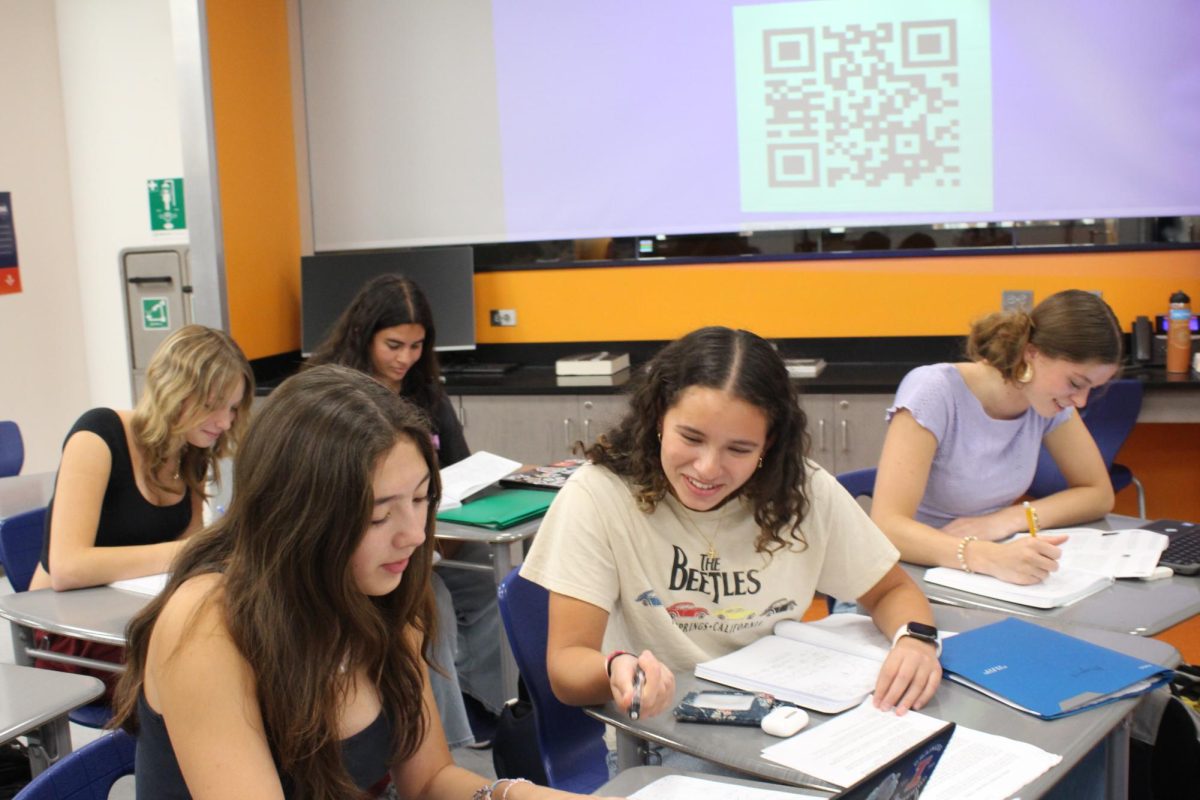Athletic trainers: the backbone of ETHS
Through ETHS’ expansive athletic training program, students work alongside professionals, benefitting both student trainers and athletes.
Student athletic trainers participate in a demo of proper hand taping.
March 15, 2023
Anyone familiar with the ETHS gym wing knows it’s synonymous with a maze, with twelve gyms riddled throughout various cement halls and various classrooms scattered throughout. Signs hang overhead, like an airport, directing traffic to the right location, and underneath, students hold their necks up at right angles, squinting to find the appropriate route to their destination. But amidst all of the commotion, tucked away in a quiet corner at the end of a bare hallway, lies an understated gem of ETHS: the athletic training room.
Peering into the narrow window that occupies the center of the wooden door, students fill the wide room, often in clusters around tables or seats. Sitting on countertops lined against the left end, athletes mingle with ice packs wrapped to their hamstrings, biceps, and calves, and on the opposite side of the room, a soccer player sits on the blue cushioned bench with her leg extended outwards and three other students surrounding and examining her. Although distant from other athletic centers, the room is certainly never desolate.
“The training room, it’s a community. People come in, everyone says hi [and] people are very friendly. There’s no issues, everyone’s just there to get better, and we’re there to help them,” shares junior Charlotte Elwell, a varsity student trainer.
At ETHS, athletic training is considered a JV or varsity sport, and Elwell is just one of many students who take advantage of this unique opportunity.
“Our athletic training program dates way back, prior to the 70s . . . It has always been a big part of our athletic training program to have students involved, and I feel like in the last couple of years we’ve really exploded with the number of students that are involved,” Athletic Director Chris Livatino notes.
This year, a total of 100 student trainers across three varsity seasons accompanied and aided Head Athletic Trainer Khaliah Elliston and Assistant Athletic Trainer Acadia Harding in managing, preventing and rehabilitating student athlete injuries.
“[Student trainers are] able to tape athletes up with some of the tapings that they have learned, they know how to run basic rehab protocols for our athletes, they know how to set up our fields for games and practices . . . they’re the extension of us that we so desperately need at [a] high school of this size,” Elliston shares.
At every ETHS sporting event, representation from the athletic training program occupies the sidelines, standing ready to tend to any injuries that may arise, which is only made possible by the students eager to engage in this sports medicine practice.
“I started freshman year in the fall. I had heard about it, and I knew I wanted to go into the medical field; I thought this would give me insight [on whether or not] that’s something I actually wanted to do, and I loved it. I loved getting to deal with injuries, so I just kept doing it,” senior varsity trainer Aoife Lucas notes.
For students who yearn to learn more about the medical landscape, the athletic training program is about as hands-on as it gets, which provides students with professional skills that would otherwise be inaccessible.
“You don’t know it until you’re in it. You can practice [athletic training skills], but it’s totally different when somebody’s running at you with blood gushing out of their nose. It takes in-game experience [to learn effectively],” senior varsity trainer Lizzie Mertz explains. “It can be nerve-wracking when you’re at that game, and you have to make those quick decisions for the first time, but with more practice and experience, Khaliah and Acadia equip us with the skills and the knowledge that we need; we just need to trust ourselves, know that we know [what to do] and know to apply [that] to what we’re doing.”
Recently, a wave of awareness surrounding the importance of athletic training has presented itself, but that wasn’t always the case. On Jan. 2, 2023, NFL player Damar Hamlin fell into cardiac arrest mid-game, and thankfully, athletic trainers came to the rescue, shining light on the significance of athletic training.
“People don’t really think we do a lot, but they won’t know how much we do until they get hurt,” Lucas shares.
While larger audiences are beginning to see the work of athletic trainers during in-game incidents, many still fail to understand the true dedication of their occupation. Dealing with game-time injuries is only a fraction of the workload; athletic trainers also specialize in injury prevention and rehabilitation.
“[Athletic training] is really important for the immediate, on-field, emergency situations, like we saw in the NFL, but I also think it’s really important, at this age, to help prevent chronic injuries and overuse injuries that can happen a lot from overtraining at the high school level,” Harding explains. “It’s really important to implement us into helping mitigate those types of injuries that can lead to more significant injuries on the field.”
Both the professional trainers and student trainers work with student athletes everyday, guiding them through prevention and rehab procedures in order to decrease the risk of critical injuries emerging.
“I got injured playing my sport, so it’s nice to see the other side of sports, to see how people help athletes recover through rehab,” freshman varsity trainer Mike Szlaga shares.
The trainers want to help the athletes, and the athletes want to receive help from the trainers; it’s a symbiotic relationship that nourishes ETHS athletics.
“I wanted to get into athletic training at the high school level because I like working with athletes that want to get better. Initially, I wanted to do physical therapy because I like the [aspect of] healing through an injury; I like helping someone with that,” Harding explains. “But I learned quickly that a lot of people that are in physical therapy don’t necessarily want to get better—it’s like a chore for them. I wanted to be like in a population where kids were [wanting] to get better … [and demonstrating] that drive.”
Through this passion for healing, the Evanston athletic training program has formed a community and provided students with meaningful experiences.
“[Athletic training is] mostly working with athletes and getting to know them really well. We pretty much see the same faces everyday, so we know their rehab [needs, and] we know how to help them in the best way we can,” Lucas describes.
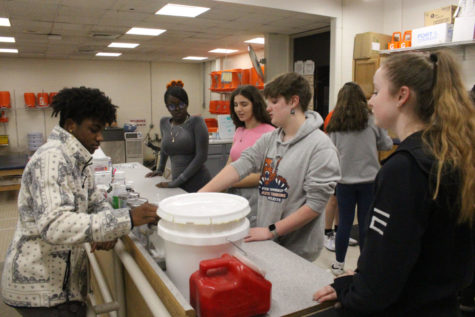
Despite the unwavering work ethic of the program, and the field broadly, misconceptions surrounding the industry still persist, and it’s a continual effort to dismantle these inaccurate perceptions.
“[For] a lot of people, when they hear ‘athletic trainers,’ they think of a personal trainer. [This] profession has a lot of work to do to promote what we are because we are an allied workcare profession, and a lot of people don’t see it that way,” Harding notes.
Not only is there a lack of recognition surrounding the profession, but there’s also a shortage of trainers. Only six out of the 152 Chicago public high schools have certified athletic trainers due to a lack of resources and priority surrounding the profession.
“I didn’t have an athletic trainer [at my high school]. I [was] born and raised in the city of Chicago, [and] I went to [a] high school in Chicago which is about 40 minutes from here. There’s not many schools in the inner city of Chicago that have athletic trainers—I didn’t even know what that was [in high school], so that played a big role in why I chose to get into it,” Elliston explains. “My biggest goal, when it’s all said and done, is to be able to give back to the community that I come from. Once you reach the suburbs, i.e. out in this area, it’s unheard of for [high schools] to not have an athletic trainer, where it’s the complete opposite in the inner city: for them to have an athletic trainer is unheard of, so I feel like our city kids get the short end of the stick.”
One reason for the shortage is explained by the 2015 decision to change the educational requirement for athletic trainers from a bachelor’s degree to a master’s degree, making it harder for trainers to enter the field entirely and leaving many schools vacant in terms of athletic training programs. However, a CPS program went into effect this year, and it includes allocating more money to increase the number of athletic trainers across high schools and partnering with Athletic Therapeutic Institute (ATI) Physical Therapy to make this possible.
“We have so many schools that we don’t have enough trainers to go to every school right now,” says CPS Director of Sports Administration Mickey Pruitt. “We tried to build up the program where trainers are at multiple events now. But at every school [trainers are] much needed, which we don’t have right now.”
In the spirit of continual strides towards expanding the reach and recognition of athletic training, there’s one final component that still requires growth: appreciation.
“It’s really easy to take athletic trainers for granted because you only realize that they’re there when you need them. If you don’t need them, you can forget about them, but when you do need them they are the heroes,” Livatino notes.
At the root of every hero, there’s selflessness. Despite the frequent lack of gratitude surrounding the athletic training field, there’s still passion that infiltrates the industry, keeping all athletes afloat.
“You don’t see us getting a lot of kudos for [the work] that [we do], but I don’t do it for the kudos either,” Elliston remarks. “I do what I feel is necessary for our kids to be safe. As long as they get back to their sports safely, and they’re happy, and they’re good, my job’s complete.”


